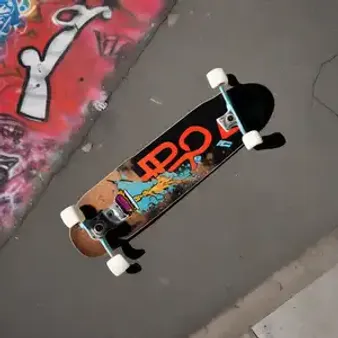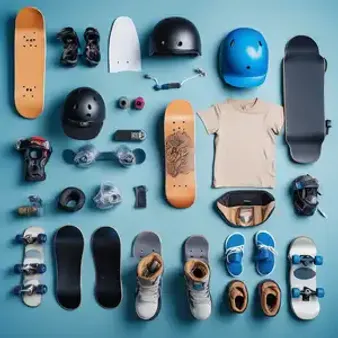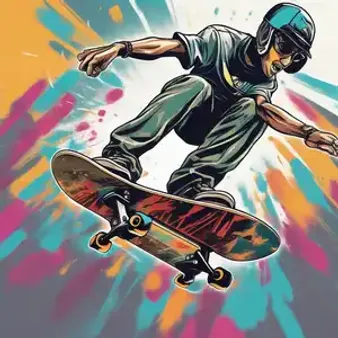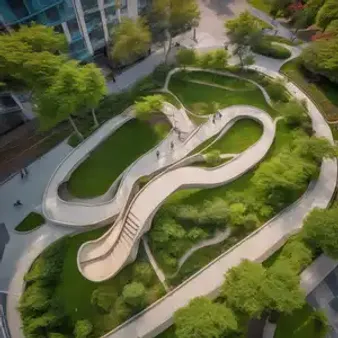Table of Contents
Hitting the streets on a skateboard is a thrilling experience, but it can be intimidating for beginners. Whether you're drawn to the creativity of tricks or simply want to cruise around town, finding the right skateboard for street skating is crucial. That's where kizworld comes in! We'll guide you through choosing the perfect board, essential gear, and basic techniques to get you started on your street skating adventure.
Feature | Description |
|---|---|
Type of Skateboard | Standard popsicle shape with a durable deck, ideal for street skating. |
Deck Size | Choose a width that suits your shoe size and skating style. 7.75" to 8.25" is a good starting point for most beginners. |
Trucks | Durable trucks with a standard kingpin design offer stability and responsiveness for street skating. |
Wheels | Harder wheels (99A-101A) are best for street skating, providing speed and durability on rough surfaces. |
Bearings | High-quality bearings (ABEC 7 or higher) ensure a smooth and fast ride. |
Protective Gear | Always wear a helmet, knee pads, and elbow pads to stay safe while skating. |
Basic Tricks | Start with ollies, shove-its, and pop shove-its as foundational street skateboarding tricks. |
Practice Spots | Look for smooth, open areas like parking lots, schoolyards, or skateparks with dedicated street sections. |
Choosing the Right Skateboard for Street Skating
Deck the Halls... I Mean, Your Skateboard!
Alright, so you're diving into the awesome world of street skateboarding! That's rad! First things first: the deck. Imagine the deck as the skateboard's heart and soul. It's the flat part you stand on. For street skating, you want a classic popsicle shape – it's like the trusty steed of the skateboarding world. Now, decks come in different widths, usually measured in inches. If you're just starting out, aim for something between 7.75" and 8.25". It's like finding the right shoe size, you know? Too narrow, and you might feel unstable; too wide, and doing tricks might feel like trying to flip a pancake in a hurricane.
Getting Wheely Technical
Next up: wheels! Think of these guys as your skateboard's dancing shoes. For street skating, you'll want harder wheels. Look for a durometer rating (that's just a fancy word for hardness) between 99A and 101A. These bad boys are built for speed and can handle those rough streets like a champ. Softer wheels are great for cruising, but for nailing those sweet tricks, you want something durable. Trust me, there's nothing worse than having your wheels turn into jelly mid-ollie! And hey, while you're at it, don't forget about bearings – those tiny metal rings inside the wheels. They're like the oil in a car engine, keeping things smooth and fast. Look for ABEC 7 or higher for a seriously smooth ride.
Gearing Up for Glory
Now, before you hit the streets, let's talk about trucks – the metal parts that connect your wheels to the deck. For street skating, you want trucks that are sturdy and responsive. Look for something with a standard kingpin design – it's like the steering wheel of your skateboard. And speaking of steering, don't even think about hopping on a skateboard without protective gear! Helmet, knee pads, elbow pads – the whole shebang! Remember, safety first, shredding second. Plus, looking the part is half the fun, right? Think of it like this: you wouldn't play basketball without shoes, would you? Same goes for skateboarding – gear up and stay safe!
Choosing the Right Skateboard for Street Skating
Essential Gear for Street Skateboarding
Protect Yourself!
Okay, before we even talk about boards and wheels, we gotta talk safety gear. It's like, you wouldn't play video games without snacks, right? Safety gear is your best bud when you're starting out. We're talking helmet, knee pads, and elbow pads - the whole nine yards. Trust me, falling is part of the learning process, and you'll be stoked you've got that protection. Plus, looking the part is half the fun! Remember, a cracked skull isn't cool, but rocking a sweet helmet definitely is.
The Right Shoes for the Job
Next up: shoes! You're not gonna wear flip-flops to a skatepark, are you? You need some sweet kicks that can handle the wear and tear. Look for shoes with flat soles for better board control. Think of it like this: flat soles grip the board like Spiderman's hands on a wall! You'll also want something with good ankle support because, let's face it, twisted ankles are a real buzzkill. Check out our article on skateboarding shoes and socks for some awesome options! Remember, comfy feet equal happy skating!
Protective Gear | Importance |
|---|---|
Helmet | Protects your head from serious injury. |
Knee Pads | Shield your knees from scrapes and impacts. |
Elbow Pads | Protect your elbows during falls. |
- skateboard-back-pack
- skate-tony-hawk
- wknd-skateboards
Essential Gear for Street Skateboarding
Mastering Basic Street Skateboard Tricks
Ollie: Your Ticket to Airtime
Alright, let's talk about the ollie – the holy grail of skateboarding tricks. It's the foundation for pretty much every other trick you'll learn, like the kickflip or heelflip. Think of it as learning your ABCs before writing a story. To ollie, you basically jump with your board – sounds simple, right? Well, it takes a bit of practice. You use your back foot to pop the tail of the board down, then slide your front foot up to level it out in the air. It's like giving your skateboard a high five with your back foot and a fist bump with your front foot – all while flying through the air!
The Shove-it Shuffle
Once you've got the ollie down, it's time to add some steez with the shove-it. This trick is all about rotating your board 180 degrees under your feet while you're in the air. Imagine spinning a pizza dough in the air – that's kind of what your board will be doing! You start with a slight jump and use your front foot to guide the board's rotation. It takes a bit of coordination, but once you get it, you'll be shove-itting all over the place! Looking for more ways to up your skateboarding game? Check out our guides on how to manual and how to do a 180 for some next-level moves!
Trick | Description |
|---|---|
Ollie | Jumping with your skateboard. |
Shove-it | Rotating the board 180 degrees under your feet. |
Pop Shove-it | Combining an ollie with a shove-it. |
Mastering Basic Street Skateboard Tricks
Finding the Best Street Skateboarding Spots
Scoping Out the Concrete Jungle
Alright, so you've got your board, your gear, and you're itching to shred! But where do you go? Finding the perfect street skating spot is like finding a hidden treasure – it takes a bit of exploration! Start by looking around your neighborhood. Empty parking lots, especially on weekends, are like skateboarding wonderlands! Smooth concrete, curbs to grind on – it's a street skater's dream. Schoolyards after hours are another great option. Just make sure to check for any "No Skateboarding" signs, you don't want to get busted on your first day out! I remember when I first started, I found this awesome little spot behind the local library – it had this perfect ledge for practicing grinds, and it was always empty! It became my go-to spot to practice new tricks.
Seeking Out Skateparks and Urban Gems
Of course, nothing beats a good old-fashioned skatepark! These concrete playgrounds are designed specifically for skateboarding, with ramps, rails, and bowls to challenge your skills. Check online or ask other skaters in your area to find the nearest skatepark. And hey, don't be afraid to get creative! Cities are full of hidden skateboarding gems just waiting to be discovered. Staircases, benches, even walls – with a little imagination, you can turn any urban obstacle into a skateboarding opportunity! Just remember to be respectful of the environment and any pedestrians around you. Skateboarding is all about freedom and expression, but it's also about sharing the space and having good vibes. For more information, check out our guide on how to find skateboarding spots and parks.
Spot | Pros | Cons |
|---|---|---|
Empty Parking Lots | Smooth concrete, curbs, and ledges. Usually empty on weekends. | May have cars or pedestrians during business hours. |
Schoolyards | Smooth ground, benches, and stairs. Often empty after school hours. | May have "No Skateboarding" signs. |
Skateparks | Designed specifically for skateboarding with a variety of obstacles. | Can get crowded, especially on weekends. |
Urban Environments | Endless possibilities for creative skateboarding. | Requires careful consideration of pedestrians and property. |
- skateboard-back-pack
- skate-tony-hawk
- wknd-skateboards
Finding the Best Street Skateboarding Spots
Final Thought
Street skateboarding is an incredibly rewarding activity that combines physical activity, creativity, and a sense of community. Remember to start slow, be patient with yourself, and most importantly, have fun as you progress. As you gain experience and confidence, you'll discover the endless possibilities that street skateboarding offers. So grab your board, find a spot, and start shredding!